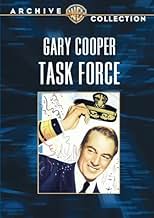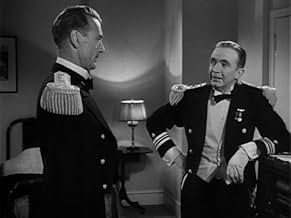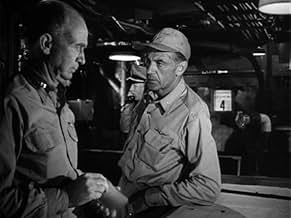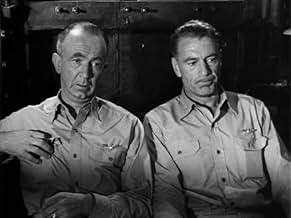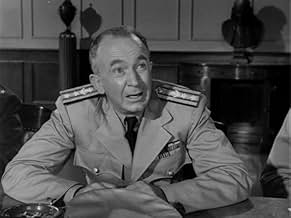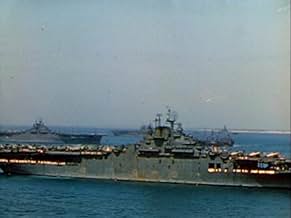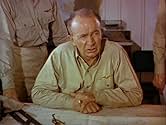Ajouter une intrigue dans votre langueAs he is retiring, Jonathan L. Scott "Scotty" reminisces about his long Navy career and the development of the role of the aircraft carrier from the early 20s.As he is retiring, Jonathan L. Scott "Scotty" reminisces about his long Navy career and the development of the role of the aircraft carrier from the early 20s.As he is retiring, Jonathan L. Scott "Scotty" reminisces about his long Navy career and the development of the role of the aircraft carrier from the early 20s.
- Réalisation
- Scénario
- Casting principal
- Récompenses
- 3 victoires au total
- Pilot
- (non crédité)
- Pilot
- (non crédité)
- Pilot
- (non crédité)
- Ames' Attache
- (non crédité)
Avis à la une
For all the history he witnessed, Scott had a rather tragic life. He wanted to be a pilot. But he gets sent to Washington, then to a desk job in Panama, then to Annapolis as an instructor, and then he is promoted to being an officer on a carrier in the Pacific when WWII begins. Seldom is he in the air himself. That's not the way the film sold it, but I did notice that aspect. Then there is Scott's personal life. He falls in love with Mary Morgan (Jane Wyatt), the widow of a pilot friend of his who died in a plane crash. The two develop feelings for each other fairly quickly, but don't do anything about them for over seven years. Mary says she does not want to marry a pilot again and always worry, and ironically the way Scott's life worked out she wouldn't have been marrying one even if she married Scott early on! And then after Scott actually DOES crash his plane THEN she decides to accept his proposal! Jane Wyatt seems a little homespun for the likes of Coop, but the two actors make it work.
There's lots of actual footage of WWII aerial battles, and you can tell real care went into detail so that this film looked authentic. For some reason, the film switches over to color about two thirds into it. That is where most of the action takes place, but it is rather an odd switchover, seeming somewhat like a holdover from the 1930s when individual scenes of a black and white movie would be shot in color.
Warner Brothers put their best supporting players into this film including Wayne Morris and Bruce Bennett, and there is Walter Brennan making his eighth and final appearance in a film with Gary Cooper. There's also a very early appearance by Julie London as the wife of one of the pilots. If you are interested in naval history this is an interesting way to spend a couple of hours.
Later, when WWII arrives, the film is much more of an action flick and gives a very competent overview of the war in the Pacific. While this did employ a lot of stock footage, it was unusual in that most all of the footage was used correctly. Unlike the ridiculously historically inaccurate film, MIDWAY (1976), TASK FORCE made sure to use clips that were accurate--featuring the correct model planes for each segment of the war (whereas in MIDWAY, they often showed planes that weren't even in the naval arsenal until well after the battle as well as had dive bombers magically turn into fighter planes in mid-flight due to horrid editing blunders).
This film really has widely different appeal depending on your perspective. If you are a history teacher and airplane nut like me, then it earns a 9 because it does a really good job of conveying the history of the American aircraft carriers from its inception in the early 1920s through WWII. However, if you are not, then you might find the film a bit cold (as it often focuses more on events than people towards the middle to the end of the film) and it might seem a bit confusing if you aren't familiar with the history of these great ships.
With Pearl Harbor, Cooper's "Scottie" Scott is thrown into battle against an enemy that is much better prepared for air combat, and with the aid and leadership of his father figure, Walter Brennan, he (as metaphor) gains the recognition and ultimate victory he deserves.
I read somewhere that Gary Cooper surrendered his chance at ultra-stardom when he made certain decisions about parts that robbed his film persona of the sort of sex appeal that would have guaranteed his place as a film star/sex symbol. The reviewer said something about Cooper being more of a big brother than a lover.
I don't know if all this is true, but Cooper's image of being a friendly, decent, human hero is clearly seen in Task Force. He--and Brennan--carry this movie. The chemistry Coop has with his audience and his on-screen friend and C.O., Brennan, puts real blood and muscle into a movie that at times gets a bit too documentarian. Add in a sweet, loving performance by Jane Wyatt as the graceful and gracious military wife and you have a really human movie that works as history lesson, war film, political essay, and love story.
Finally, what I love about this film is its innate patriotism. There simply is no questioning of America's place and motive in the years leading up to and during the Second World War. We were a democracy threatened by tyranny. We were unprepared for war because we despised it so very much; once confronted, we prevailed. The stock footage of Cooper's carrier (in real life, the badly damaged USS Franklin) arriving at New York with her flight deck and upper hull twisted into scrap metal by Japanese explosives is startling, a metaphor for the cost of not being prepared with the sort of cutting-edge technology, training, and will that might have reduced the bloodiness of the war or prevented it all together.
Le saviez-vous
- AnecdotesWayne Morris who portrayed Lt.McKinney was the only actor in the cast who had actual combat experience as a carrier pilot in WWII. As a fighter pilot, Morris shot down seven enemy planes and contributed to the sinking of five enemy ships. He was awarded four Distinguished Flying Crosses and two Air Medals. He was the only combat "ace" of all the Hollywood actors who went to war.
- GaffesDuring the attack sequence on the Japanese carriers at Midway, the film shows the dive bombers striking first. Actually, it was the torpedo bombers that attacked first. This was caused by missed communications between the torpedo planes and the fighter cover. It was supposed to be a coordinated high-low attack. Almost every torpedo plane was shot down. No torpedoes made hits. While a tragic accident, the torpedo planes drew the Japanese fighter cover down to wave top height. When the U.S. fighters and dive bombers arrived there were very few Japanese fighters to intercept them.
- Citations
Pete Richard: The disarmament conference is over. They've sunk the fleet. The Missouri, the South Dakota, the Maine, the Virginia, Nebraska Georgia. 30 capital ships. More ships sunk with the stroke of a pen than have been sunk in our entire history.
- ConnexionsEdited from Pearl Harbour (1943)
- Bandes originalesTea for Two
(uncredited)
Music by Vincent Youmans
Played when Cmdr. Richard introduces Lt. Scott to the Admiral and his wife
Meilleurs choix
- How long is Task Force?Alimenté par Alexa
Détails
- Durée
- 1h 56min(116 min)
- Couleur
- Rapport de forme
- 1.37 : 1


